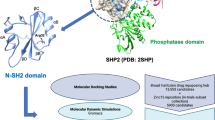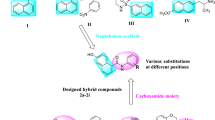Abstract
In our search for novel bioactive molecules, three series of indolin-2-one derivatives incorporating 1-benzyl-1H-1,2,3-triazole moiety were synthesized. The compounds were initially designed as acetylcholine esterase (AChE) inhibitors based on the structural feature of donepezil, a known AChE inhibitor which is currently used clinically to treat Alzheimer’s disease (AD). Two compounds 4g and 3a were found to be the most potent in inhibition of AChE with inhibition percentages of 51 and 50% when tested at the concentration of 100 μM. Docking assays were carried out in order to explain the structure–activity relationships of these compounds compared with Donepezil against AChE enzyme. In DPPH free radical-scavenging assay, most compounds showed only weak scavenging activity. Noteworthy, additional cytotoxic evaluation of the compounds against three human cancer cell lines (SW620, human colon cancer; PC3, prostate cancer; NCI-H23, lung cancer) revealed that five compounds, including 3c, 3e, 5c, 5e, and 5g, exhibited strong cytotoxicity (IC50 values in the range of 0.65–7.17 µM). Compound 5g was the most potent one with IC50 values as low as 0.65 μM, even more potent than adriamycin, a positive control. Thus, compound 5g would be promising for further development as an anticancer agent.








Similar content being viewed by others
References
An J, Totrov M, Abagyan R (2005) Pocketome via comprehensive identification and classification of ligand binding envelopes. Mol Cell Proteom 4(6):752
Arthur DE, Uzairu A (2019) Molecular docking studies on the interaction of NCI anticancer analogues with human phosphatidylinositol 4,5-bisphosphate 3-kinase catalytic subunit. J King Saud Univ Sci. 31(4):1151–1166
Cheung J, Rudolph MJ, Burshteyn F, Cassidy MS, Gary EN, Love J, Franklin MC, Height JJ (2012) Structures of human acetylcholinesterase in complex with pharmacologically important ligands. J Med Chem 55(22):10282–10286
Dassault Systèmes BIOVIA (2016) Discovery studio modeling environment. Accelrys Inc, San Diego, CA, USA
Ellman GL, Courtney KD, Andres V, Featherstone RM (1961) A new and rapid colorimetric determination of acetylcholinesterase activity. Bio Pharm 7(2):88–95
Huang Y, Mucke L (2012) Alzheimer mechanisms and therapeutic strategies. Cell 148(6):1204–1222
Kim Y, You YJ, Nam NH, Ahn BZ (2002) Prodrugs of 4′-demethyldeoxypodophyllotoxin: synthesis and evaluation of the antitumor activity. Bioorg Med Chem Lett 12:3435–3438
Kumar A, Singh A, Ekavali (2015) A review on Alzheimer’s disease pathophysiology and its management: an update. Pharm Rep. 67(2):195–203
Massoulié J, Pezzementi L, Bon S, Krejci E, Vallette F-M (1993) Molecular and cellular biology of cholinesterases. Prog Neurobiol 41(1):31–91
Molecular Operating Environment (MOE) 2019.01 chemical computing group ULC (2019) 1010 Sherbooke St. West, Suite #910, Montreal, QC, Canada, H3A 2R7
Nam NH, Huong TL, Dung DTM, Dung PTP, Oanh DTK, Park SH, Kim K, Han BW, Yun J, Kang JS, Kim Y, Han SB (2014) Synthesis, bioevaluation and docking study of 5-substitutedphenyl-1,3,4-thiadiazole-based hydroxamic acids as histone deacetylase inhibitors and antitumor agents. J Enzym Inhib Med Chem 29(5):611–618
Nam NH, Pitts RL, Sun S, Sardari S, Tiemo A, Xie M, Yan B, Parang K (2004) Design of tetrapeptide ligands as inhibitors of the Src SH2 domain Bioorg Med Chem 12(4):779–787
Neves MA, Totrov M, Abagyan R (2012) Docking and scoring with ICM: the benchmarking results and strategies for improvement. J Comput Aided Mol Des 26(6):675–686
Olivero G, Grilli M, Chen J, Preda S, Mura E, Govoni S, Marchi M (2014) Effects of soluble β-amyloid on the release of neurotransmitters from rat brain synaptosomes. Front Aging Neurosci 6:166
Özdemir Z, Yılmaz H, Sarı S, Karakurt A, Şenol FS, Uysal M (2017) Design, synthesis, and molecular modeling of new 3(2H)-pyridazinone derivatives as acetylcholinesterase/butyrylcholinesterase inhibitors. Med Chem Res 26(10):2293–2308
Rodda J, Carter J (2012) Cholinesterase inhibitors and memantine for symptomatic treatment of dementia. BMJ 344:e2986
Semenov VE, Zueva IV, Mukhamedyarov MA, Lushchekina SV, Kharlamova AD, Petukhova EO, Mikhailov AS, Podyachev SN, Saifina LF, Petrov KA, Minnekhanova OA, Zobov VV, Nikolsky EE, Masson P, Reznik VS (2015) 6-Methyluracil derivatives as bifunctional acetylcholinesterase inhibitors for the treatment of Alzheimer’s disease. ChemMedChem 10(11):1863–1874
Singh M, Kaur M, Kukreja H, Chugh R, Silakari O, Singh D (2013) Acetylcholinesterase inhibitors as Alzheimer therapy: from nerve toxins to neuroprotection. Eur J Med Chem 70:165–188
Skehan P, Storeng R, Scudiero D, Monks A, McMahon J, Vistica D, Warren JT, Bokesch H, Kenney S, Boyd MR (1990) New colorimetric cytotoxicity assay for anticancer-drug screening. J Natl Cancer Inst 82(13):1107–1112
Thuong PT, Na MK, Dang NH, Hung TM, Ky PT, Thanh TV, Nam NH, Thuan ND, Sok DE, Bae KH (2006) Antioxidant activities of Vietnamese medicinal plants. Nat Prod Sci 12:29–37
Tung TT, Oanh DTK, Dung PTP, Hue VT, Park SH, Han BW, Kim Y, Hong JT, Han S-B, Nguyen-Hai N (2013) New benzothiazole/thiazole-containing hydroxamic acids as potent histone deacetylase inhibitors and antitumor agents. Med Chem 9(8):1051–1057
Wu L, Smythe AM, Stinson SF, Mullendore LA, Monks A, Scudiero DA, Paull KD, Koutsoukos AD, Rubinstein LV, Boyd MR, Shoemaker RH (1992) Multidrug-resistant phenotype of disease-oriented panels of human tumor cell lines used for anticancer drug screening. Cancer Res 52(11):3029–3034
Ye G, Nam NH, Kumar A, Saleh A, Shenoy DB, Amiji MM, Lin X, Sun G, Parang K (2007) Synthesis and evaluation of tripodal peptide analogues for cellular delivery of phosphopeptides. J Med Chem 50:3604–3617
Yiannopoulou KG, Papageorgiou SG (2013) Current and future treatments for Alzheimer's disease. Ther Adv Neurol Disord 6(1):19–33
Acknowledgements
We acknowledge the principal financial supports from the National Foundation for Science and Technology of Vietnam (NAFOSTED, Grant number 104.01-2018.301). The work was also partly supported by a grant funded by the Korean Government (NRF, Grant number 2017R1A5A2015541).
Author information
Authors and Affiliations
Corresponding authors
Ethics declarations
Conflict of interest
The authors declare that they have no conflict of interest.
Additional information
Publisher’s note Springer Nature remains neutral with regard to jurisdictional claims in published maps and institutional affiliations.
Supplementary material
Rights and permissions
About this article
Cite this article
Lan, T.T., Anh, D.T., Hai, PT. et al. Design, synthesis, and bioevaluation of novel oxoindolin-2-one derivatives incorporating 1-benzyl-1H-1,2,3-triazole. Med Chem Res 29, 396–408 (2020). https://doi.org/10.1007/s00044-019-02488-1
Received:
Accepted:
Published:
Issue Date:
DOI: https://doi.org/10.1007/s00044-019-02488-1




